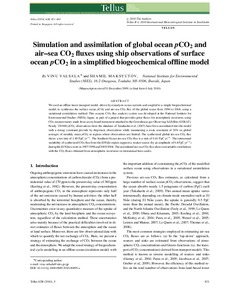Simulation and assimilation of global ocean pCO2 and air–sea CO2 fluxes using ship observations of surface ocean pCO2 in a simplified biogeochemical offline model.

View/
Average rating
votes
Date
2010Author
Valsala, Vinu
Maksyutov, Shamil
Metadata
Show full item recordAbstract
We used an offline tracer transport model, driven by reanalysis ocean currents and coupled to a simple biogeochemical
model, to synthesize the surface ocean pCO2 and air–sea CO2 flux of the global ocean from 1996 to 2004, using a
variational assimilation method. This oceanic CO2 flux analysis system was developed at the National Institute for
Environmental Studies (NIES), Japan, as part of a project that provides prior fluxes for atmospheric inversions using
CO2 measurements made from an on-board instrument attached to the Greenhouse gas Observing SATellite (GOSAT).
Nearly 250 000 pCO2 observations from the database of Takahashi et al. (2007) have been assimilated into the model
with a strong constraint provide by ship-track observations while maintaining a weak constraint of 20% on global
averages of monthly mean pCO2 in regions where observations are limited. The synthesized global air–sea CO2 flux
shows a net sink of 1.48 PgC yr−1. The Southern Ocean air–sea CO2 flux is a si.....
Journal
TellusVolume
62BPage Range
pp.821–84Document Language
enEssential Ocean Variables (EOV)
Inorganic carbonStable carbon isotopes
Best Practice Type
Best PracticeStandard Operating Procedure
DOI Original
10.1111/j.1600-0889.2010.00495.xCitation
Valsala. V. and Maksyutov, S. (2010) Simulation and assimilation of global ocean pCO2 and air–sea CO2 fluxes using ship observations of surface ocean pCO 2in a simplified biogeochemical offline model. Tellus, 62B, pp.821-840. DOI: 10.1111/j.1600-0889.2010.00495.xCollections
 Repository of community practices in Ocean Research, Applications and Data/Information Management
Repository of community practices in Ocean Research, Applications and Data/Information Management